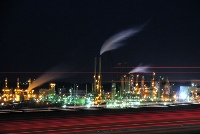Global oil, gas firms poised for strong 2011 finish despite market uncertainty - report
 Though third-quarter financial news has been decidedly more bearish than bullish, advisory firm Ernst & Young's oil and gas center says it anticipates a steady close to the year. The oil and gas industry is set to end 2011 strong amid great uncertainty in the broader market, according to the firm’s quarterly oil and gas update.
Though third-quarter financial news has been decidedly more bearish than bullish, advisory firm Ernst & Young's oil and gas center says it anticipates a steady close to the year. The oil and gas industry is set to end 2011 strong amid great uncertainty in the broader market, according to the firm’s quarterly oil and gas update.
"I would not characterize the economy as robust and thriving by any means, but the oil and gas industry is holding up well," said Marcela Donadio, Americas oil and gas leader for Ernst & Young LLP. "New sources of energy supply and the globalization of energy markets have created opportunity and balance for the industry."
The recent dip in prices for oil and gas reflects increasing supply and declining demand worldwide, in response to manufacturing slowing and consumer confidence retrenchment.
Simultaneously, as the value of the Euro has decreased, the value of the dollar has grown. And Libyan crude supplies have started to return.
All of this has resulted in some relief at the pump for consumers and a balancing of supply and demand fundamentals for the industry, the firm said.
Oil
Physical crude markets are reasonably balanced but tight, with global oil prices holding steady at around or upward of $100/bbl.
On the non-OPEC side of the market, crude production showed some increases this year, with production growth in North American crude, primarily from US shale and from Canadian oil sands, along with gains in Brazil and Russia, offsetting declines in Europe.
However, spare capacity in OPEC remains low. This creates tighter markets, with prices tending to move up sharply with relatively small increases in demand.
The big unknown is which way demand will move, with a broad lack of confidence in demand estimates right now and forward-demand estimates coming down.
So far, Asia and the emerging economies have managed to hold up their part in the demand equation, but growth in China – which has been the big demand growth driver for the past five years – is expected to slow.
That will have a negative impact on demand and cause further weakening in commodity prices.
Gas
Natural gas production continues to boom. US gas production is at its highest level in almost 40 years and storage is once again at a normal level. After struggling early in the recent decade, sustained investment and drilling activity, along with technology advances, finally started to pay off.
But gas demand growth has struggled with the broader economy and remains largely at the mercy of the weather. In its latest forecast, the US Department of Energy sees modest demand growth continuing this year and next.
Oilfield services
As unconventional, service-intensive projects increase, so has the demand for equipment and services with subsequent increases in costs.
To ensure access to needed equipment, supplies and personnel, some large independents, including Chesapeake, Pioneer and EOG Resources Inc., are moving to own and operate the equipment and services they will need.
Decades ago, service functions were largely "in-house." Upstream companies typically owned and managed the service function.
But as drilling processes became more specialized during the 1970s and 1980s, and operators chose to focus more on "core competencies," those functions were increasingly spun off to an independent oilfield services segment.
The industry is starting to see a "reintegration" of the service function into upstream companies as a means of ensuring access to those services and managing capital costs.
Downstream
Despite the strong rise in crude oil prices, US refiners have generally had a good year thus far, according to Ernst & Young. Midcontinent refiners in particular, with access to the relatively undervalued crude oils like WTI and Canadian heavy, generally saw much stronger gains than those more exposed to global crude oil markets, such as the coastal refiners.
However, two key issues could impact this positive momentum: 1) Additional global refining capacity continues to be added, 2) export-oriented economies, which have generated the bulk of demand growth for refined products, will decrease demand in response to economic malaise in developed countries.
These factors will increase supply pressures, drive down demand for refined products and dilute margins, according to the report.
Transactions and Conclusions
Third quarter oil and gas transaction activity was once-again solid. While there were some gains over the previous quarter, it was nowhere near the volume and value that we saw at the end of last year.
With Kinder Morgan's $21.1 billion acquisition of El Paso Corp. getting the fourth quarter off to a strong start, Ernst & Young expects to see continued growth in deal volume for the remainder of 2011 and into 2012.
In the end, the industry has evolved in such a way that it is less impacted by the lagging economies of developed countries.
The industry has globalized, diversified and created additional opportunities, thereby making it better able to protect against broader market fluctuation.






Comments